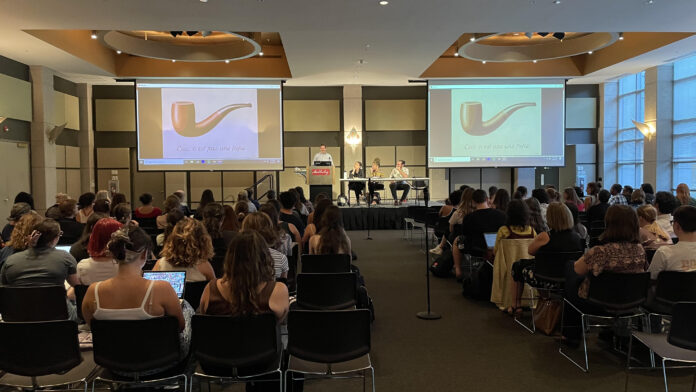On Sept. 6, the Center of Ethics had their opening event for this year’s theme, “The Ethics of the Image,” at Miller Forum. It featured a faculty panel who specialized in a variety of disciplines. These faculty members included Professor of English & Africana Studies Emanuela Kucik, Ph.D., Professor of Media & Communication Jefferson Pooley, Ph.D., Professor of Art History Elena FitzPatrick Sifford, Ph.D., and Stanley Road Professor of Neuroscience Jeremy Teissere, Ph.D.
The co-directors of the program are Professor of Media & Communication Paul McEwan, Ph.D., and Elena FitzPatrick Sifford, Ph.D. McEwan started the event by saying, “[We are] much more likely to believe things we have seen rather than what we cannot see. [For example,] science is more believable if we have seen it in comparison to things we haven’t seen.”
When asked about the theme, McEwan stated, “We should emphasize that although a Center [of Ethics] theme of ‘The Ethics of the Image’ sounds like it would weigh heavily on art and film and related fields, we really want to consider the ways in which images create ethical concerns across disciplines. A long term goal of the Center for Ethics has been to explore the types of interdisciplinary questions that create connections across campus and draw links between the apparently different types of intellectual work that Muhlenberg students and professors do together. This year’s program will continue that tradition.”
“although a Center [of Ethics] theme of ‘The Ethics of the Image’ sounds like it would weigh heavily on art and film and related fields, we really want to consider the ways in which images create ethical concerns across disciplines.
Paul McEwan Ph.D.
FitzPatrick Sifford’s talk was titled “Representing the Black Body: A Broad View of Depicting Bodily Comportment & Racialization from Colonization to the Present.” She looked at how art has portrayed Black people over time in both a dishonoring and empowering perspective. She used a quote from Krista Thompson, Ph.D., professor of art history at Northwestern University, saying, “Who knew better the meaning and uses of the visual in Western society than those who were defined as Black, as other, as property, based on the surface appearance of their skins?” In one piece of artwork that lacked color, the artist used a cross hatching technique, which was able to show dark skin even with no color. In this piece, Blackness was portrayed as a sin and there was an attempt to clean this Blackness off the body. In contrast, in “Abolitionist Medallion” by Josiah Wedgwood, a ceramic medallion that was created to promote the abolition of the slave trade. This medal was given out at abolition society meetings to promote the cause.
The Emancipation Memorial by Thomas Ball shows “Lincoln [as] the great white savior while the Black man is kneeling… The subordinate pose convey[s] meaning about racialized hierarchies.” The monument has received criticism for its paternalistic character of the slave pictured in the memorial. In fact, Frederick Douglass said that the statue “showed the negro on his knees when a more manly attitude would have been indicative of freedom.” Kneeling can have different meanings depending on the context. In 2016, football player Colin Kaepernick kneeled before a match when the national anthem played because he couldn’t stand to exhibit pride and respect for a flag of a country that oppressed Black people and perpetuated systemic racism. To conclude, Sifford said the “power of image [is used] as a means of communication, protest, and hopefully change.”
Kucik’s talk was titled “We Charge Genocide: Lynching, Genocide, and the Role of Imagery in Perpetuating and Dismantling Anti-Black Violence.” Kucik started by defining lynching as “violent public acts that white populations used to terrorize and control Black populations. [This includes] torture, mutilations, people burned alive and public display. Photographs of lynching [were] sold as souvenir postcards. These postcards were used to dehumanize Black people. These images allowed them to celebrate anti-Black violence. They were used as teaching tools for many generations of white people to see these Black people in this state. They were teaching young children that this was the right way to see Black people.” Kucik ended her talk saying how “a video or image can cause tangible change.”
Teissere, Stanley Road Professor of Neuroscience’s talk was titled “The Thickness of the Image: Codes, Contingencies, and Spectral Choices.” He focused on “how images are made and then how those images are used or rather what those images can do.” He referenced how the falsification of images can even happen in academia. For example, he discussed how the previous President of Stanford Marc Tessier-Lavigne, Ph.D., was guilty of authoring lab reports that had forged information including digitally altered images and blot results taken from other papers. Teissere commented, “detection is really hard. Academic peer review journals are not well researched to detect fraud.” Tessier-Lavigne ended up resigning due to the forgery found in his research. Teissere stated the importance of images as “I think we need to care how images are made, and how technology (& our access to it and understanding of it) as well as the shadowy hand of the market deeply influence how images are made. That is, that they aren’t simply ‘pictures’ that we share – and that in science especially, how images are made affects how we name and consider ‘the truth.’ If dishonest data fools us into thinking they tell us something ‘true,’ our understanding of phenomena can become distorted, with major ramifications on policy, politics, regulation of the market, and what we think reality really is.”
“I think we need to care how images are made, and how technology (& our access to it and understanding of it) as well as the shadowy hand of the market deeply influence how images are made. That is, that they aren’t simply ‘pictures’ that we share – and that in science especially, how images are made affects how we name and consider ‘the truth.'”
Jeremy Teissere Ph.D.
Pooley’s talk was titled “The Image Medium is the Ethical Message.” His point was “to show that there are interesting ethical implications one can draw from looking at the image as a particular medium, with formal properties like stillness, silence, all-at-once perception and the like.” Pooley emphasized that “images are still, motionless and static. They are silent and don’t speak back.”
Kabir Burman ‘27 stated, “I like the idea of the themes they were discussing, especially the transatlantic slavery part. As someone who is interested in photojournalism, I’m interested in how an image can influence narratives. Dr. Sifford mentioned how images have the power to influence narratives, and they can be altered just based on an image.”
An anonymous student said that “I’m a Dana scholar and we are required to go to every Center for Ethics event. This is kind of a difficult task because I’m already really busy with homework and other obligations, so it can be difficult to make it to every event. I’m excited to learn more about the ethics of the image though.”
Shaiyan Feisal '26 is a neuroscience major with a minor in public health. She enjoys writing news and arts & culture pieces to highlight the various voices among the student body and show the variety of commodities Muhlenberg has to offer. When she isn't writing, she enjoys reading murder mystery novels and painting.























